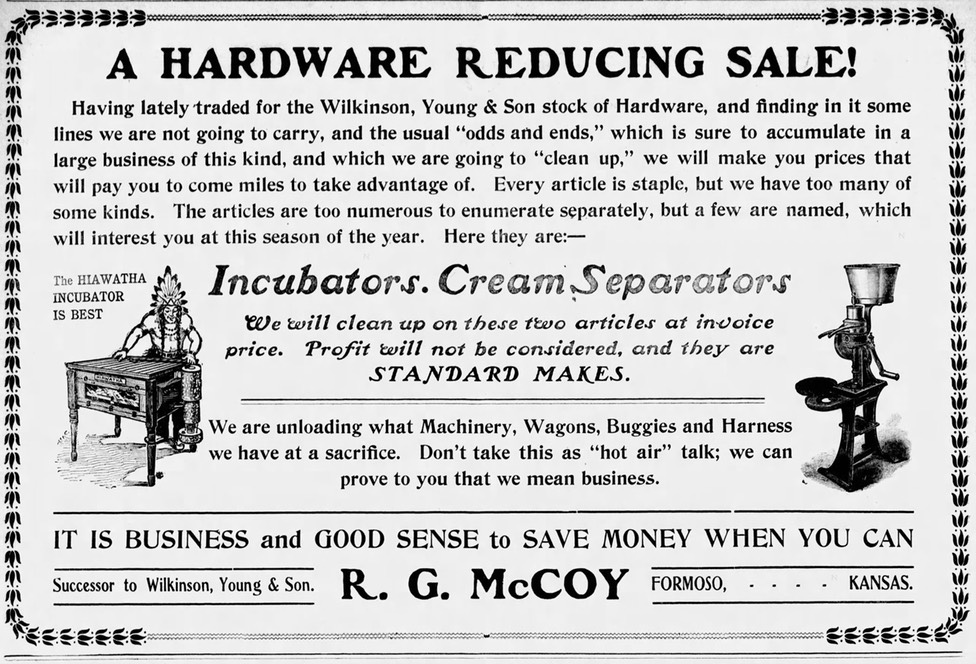I’ve had enough good fortune turning up interesting finds on eBay that I remind myself to drop in from time to time. A few days ago I ran across four of the best photographic views of Formoso’s Main Street that I’ve ever seen. One was the picture of Master Harvey Turnby and his pony which I wrote a brief entry about earlier this week.
It was midmorning when I discovered those four pictures. That afternoon I learned from Bill Blauvelt of the Superior Express that an artist working on a mural was looking for a better likeness of something called “the Formoso gazebo.” I immediately assumed that the artist meant the bandstand that sat for decades at the intersection of Main and Patterson, covering the city’s old well. After all, what is a bandstand if not a gazebo with a singular purpose? Consulting a copy of my mother’s book of Formoso history just to be certain, I was reminded that the bandstand was relocated to the city park in the 1940’s, when the well which sat beneath it was filled in. The town had a water tower now. Water no longer had to be pumped out of the well to fight the city’s frequent and sometimes devastating fires.
Happily, three of the four pictures I had found that very morning also include the largest, most-detailed views of the Formoso bandstand I've yet seen. The fourth picture is the one below, which was apparently shot from atop the bandstand.
In 1908, “Wilkinson purchased McCarthy’s Hardware, adding clock, shoe and harness repair departments,” according to Formoso: The Tracks of a Town. However, the Formoso New Era did not announce the actual arrival of the new owners until April of 1909.
They apparently hit the ground running with a flurry of ads appearing in the local paper every week for several months.
The owners also may have employed a penny-postcard blitz to help get the word out. It’s surely no coincidence that someone climbed to the pinnacle of the bandstand to obtain an eagle’s-eye view of southwest Main, a view featuring a single storefront which has prominent signage. We can also guess approximately when the picture must have been taken.
The advertisement visible in the window of the Mercantile Building next door to Wilkinson’s reminds passersby that the Old Settlers Day celebration would be held in the town of Jewell City on August 12, 1909. Posters for the event probably went up at the start of summer.
Newspaper advertisements for the new store began trailing off in August and seemed to vanish completely in September. The following January a new message began to appear in a prominent typeface.
It will be appreciated if those knowing themselves to be indebted to Wilkinson, Young & Son will call and settle their account.

A few months later R. G. McCoy, who owned a land office and was also vice-president of the Union State Bank, decided to take over the failing store and its slew of unsold off-brand merchandise. McCoy made sure to advertise the incredible savings available to shoppers in several consecutive issues of the New Era.
McCoy’s ad seems to indicate that once the unwelcome inventory was cleared out the building would continue to serve as a hardware store, although this does not seem to be what actually happened.
Here’s what did happen, according to my mother’s book of Formoso history:
The Beedles had opened the Lyric Theatre in the hardware on south Main and were presenting four or five reels of films at each performance, accompanied by the singing of George Shedden and Rex Dix, with Margaret Randall playing piano. Films were shown Wednesday, Friday, and Saturday night, with a Saturday matinee for ten cents.
After all, Formoso still had three more hardware stores.
Serendipity is defined as an unplanned fortunate discovery, but I usually apply it to any discovery that somehow gives me goosebumps. I found the pictures of Formoso a few hours before Bill Blauvelt told me they might be needed. I validated the pictures by consulting my mother’s book of Formoso history. Bill Blauvelt’s Superior Express published the book in 1988.
When I looked up serendipity just now I discovered that the word was coined by Horace Walpole in 1854. I know who Horace Walpole was because I took History of England in the 18th Century at Kansas State University. The professor was R. Kent Donovan, who one day announced to the class, “Horace Walpole sets my heart on fire.” I suppose that’s something like the feeling we get from serendipity.